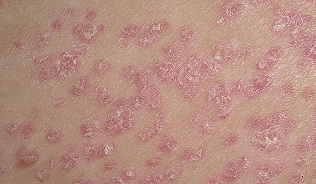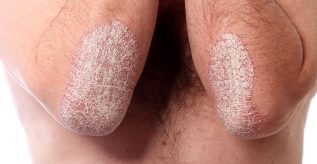Handling with psoriasis, many patients do not immediately recognize pathology, took it for allergic rashes and some other dermatitis. For the early diagnosis of the disease it is important to know how is the pathology, what are the stages of psoriasis and manifestations of the disease in different stages. The course of psoriasis is characterized by four phases, from which are issued the basic, progressive, stationary phase and phase of decline. In more detail each of the steps look in the article.
The initial phase of psoriasis

Many patients are interested in the one that looks like psoriasis in the initial stage? See the first manifestations of the disease is possible in the photo. For this stage is characterized by the development of the skin characterized by red, pink spots with clear boundaries. The disease can occur on different parts of the body. Further, the provided photo of the pathology in different parts of the body.
The symptoms of psoriasis at the initial stage
For the initial stage of the disease are typical the following symptoms:
- slight peeling of the dermis;
- redness of the skin;
- the development of itching;
- a feeling of dryness, pressure;
- the emergence of spots of different diameters;
- the gradual strengthening of the flaking.
The clinical picture of the disease can vary depending on the type of disease. So, with psoriasis in the form of droplets the size of the plaques has a smaller diameter, no more than 2 — 3 mm. In the released form, vulgar, rashes reach a considerable size than 5 cm, often intertwined between each other, forming a large lake. For pustular psoriasis the typical of education on the dermis crusting yellow or grayish hue to a bunch of serous fluid beneath them.
The initial phase lasts for each patient differently. It depends on the species, the immunity of the patient and other functions of the body.
Treatment the initial stage
For the first stages of the disease is most commonly prescribe a topical treatment of the rash with the use of ointments, gels, lotions. Treatment is focused on removing the itching, peeling, swelling, redness, inflammatory process. For this apply hormonal and non-hormonal ointments.
Hormonal drugs at the initial stage of rarely prescribe it. Often their use is indicated in patients with acute course of the disease.
Hormonal ointments often cause side effects. Their use is recommended only on doctor's prescription.
Progressive stage of psoriasis

The progressive phase is characterized by increased manifestations of the disease, the plaques are becoming more and more, itching, peeling, swelling, inflammation intensifies. Rashes on the skin begin to associate among themselves, affects a significant part of the dermis. In the stage of progress often appears such a symptom as a phenomenon kebnera. The essence of the phenomenon lies in the fact that new rashes appear in places of damage of the skin cover. If it is on the skin, there are scratches, abrasions, burns, in their place, with a high probability to appear plaques. Duration of the stage of progress in the average, it takes from 14 days to several months. For each patient, this time interval depends on the individual characteristics of the organism and how quickly immunity to cope with pathology.
Treatment of progressive stage
Acute course of psoriasis requires a comprehensive approach using the following methods:
- Treatment treatment of.
- The use of physiotherapy.
- Correction of the life style of the patient.
Important! Tactics of treatment set individually for each patient, depending on the severity of the disease, the characteristics of its flow and the presence of complications.
Medical drugs
How to get rid of plaque and reduce the symptoms of the disease in medical practice uses the following group of drugs:
- Antihistamines – are calculated on the reduction of such manifestations, such as itching, redness.
- Sedative medication – they allow you to remove the excessive nervous tension, normalizes sleep.
- Anti-inflammatories – safely peel off the inflammatory process, helping to eliminate redness and other symptoms of the disease.
- Diuretics – drugs that are destined for excretion from the body of excess fluid and salt. These drugs help to cleanse the body, which has a positive effect on the course of the disease.
- Keratolytic – promote good exfoliation of the epidermis, to create a regeneration of the dermis, its update.
- Immunomodulators – manages the work of a person's immunity, which is an important prerequisite to healing.
- Hormonal ointments – they give quick results, are applied mainly at the heavy course of the disease.
- Cytotoxic drugs – have a property to suppress the immune system, which is sometimes necessary, how to get rid of psoriatic plaques.
All medication is to be used exclusively for doctor's appointments. I only get worse during pathology.
Physiotherapy treatment
To the methods of physical therapy include:
- PUVA therapy;
- The use of ultrasonic irradiation.
- Magnetic.
- Selective therapy.
- The laser beams.
- Mud treatment.
- Paraffin wraps.
- Sanatorium treatment.
The number of sessions and their length picks up the doctor, with regard to the characteristics and type of disease, and also personal qualities and the overall health of the patient.
Folk methods

From folk therapy is recommended:
- Natural oils (juniper or lavender). Have a healing and calming effect, a beneficial effect on skin condition. Method of use: a few drops of oil add to the cream and point cause rashes.
- Hydrogen peroxide (3%). Applied point and is not washed off. Before use it is necessary to consult with a dermatologist.
- 30 grams of propolis mix with 250 ml of vegetable oil (the oil pre cook). The cooked mixture should be used for dissolving the Horny layer of the epidermis and restore skin elasticity.
- Beeswax. This product has anti-inflammatory and emollient effect. Beeswax is a need to melt in a water bath, then gently apply on the pie, covering the papules.
- Med. The main product of bees positively affects the human body with psoriasis. Must be consumed in limited quantities – 2 tablespoons a day.
Tincture against psoriasis
From folk methods of treatment are used, still the same oil and hydrogen peroxide.
To them you can add the tincture on the basis of celandine. For its preparation you will need 3 tablespoons of this plant (in dry or fresh form) and the salt water. In no case can not use alcohol, because it can overdry your skin.
How to prepare a healing agent:
- components need to mix with each other;
- leave for a couple of hours.
Before using the tincture of the skin is recommended to grease with birch tar (the point) to increase the medicinal effect.
To therapy has been effective, the patient should go on diet food, harmful products provoke a worsening of the condition.
Diet with psoriasis

Patients with psoriasis, it is important to stick to proper nutrition. Adherence to the diet will allow for faster clean the skin from the plaques, avoiding the complications of the disease.
Principles of nutritional care the following:
- It is necessary to give up the spicy, salty, sour, fried foods. These products only promote the growth of plaques.
- The diet should be saturated with a large amount of vegetables, fruits.
- In the role of a main meal is best to choose a porridge, soups, lean fish and meat.
- On the table must be present products allergens. One has to give up eggs, nuts, chocolate, citrus.
- Drinks with caffeine also excluded.
- Banned alcohol, carbonated drinks.
- Dairy products must contain fat. Preference it is necessary to give yoghurt without additives, kefir, sour.
Take food is recommended in small portions, avoid overeating. Diet – it is important, it is drawn up the therapy of the disease. Proper nutrition helps to saturate the body with vitamins, get rid of toxins and toxins.
The stationary phase
The stationary phase is characterized by a decrease in the growth of psoriatic plaques and their quantity in the body decreases, the disease seems to go into sleep mode. In the presence of provoking factors pathology from a landline, it can again move into a phase of progress. The causes of this phenomenon becomes improper treatment, refusal of adherence to diet, injury to the skin. The length of the stationary phase is so different for different patients, which is quite difficult, even suggesting its borders. On average, the time it takes from several weeks to several years.
Phase of decline,
Phase bankruptcy is the last phase before the remission of the disease. Here is celebrated the following changes:
- Colored papules of bright red passes into a pale pink shade.
- Reduces the amount of flaking.
- It's itching.
- Skin clears, acquires a uniform coloration and texture.
- While the individual parts of the body remain the so-called "guarded food stamps". As the rash completely persist, persist on the skin even in periods of remission.
Psoriasis refers to a chronic dermatitis, non-transferable character. To fully get rid of the disease to date cannot be. Patients who have a pathology, you need a whole life to adhere to preventive measures aimed at the prevention of recurrence. Many of the sick managed to maintain the period of remission, in the coming years, lead a full life.























